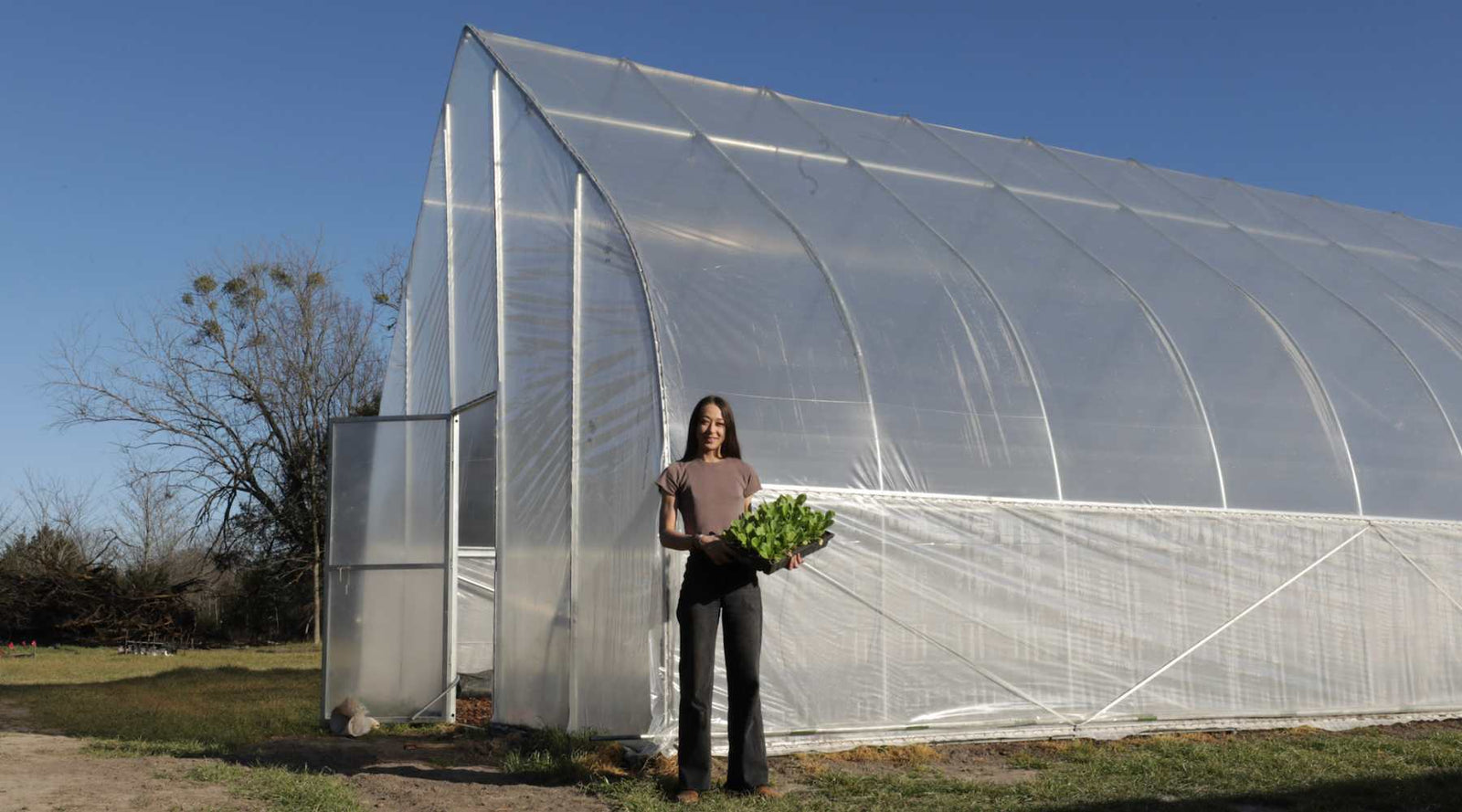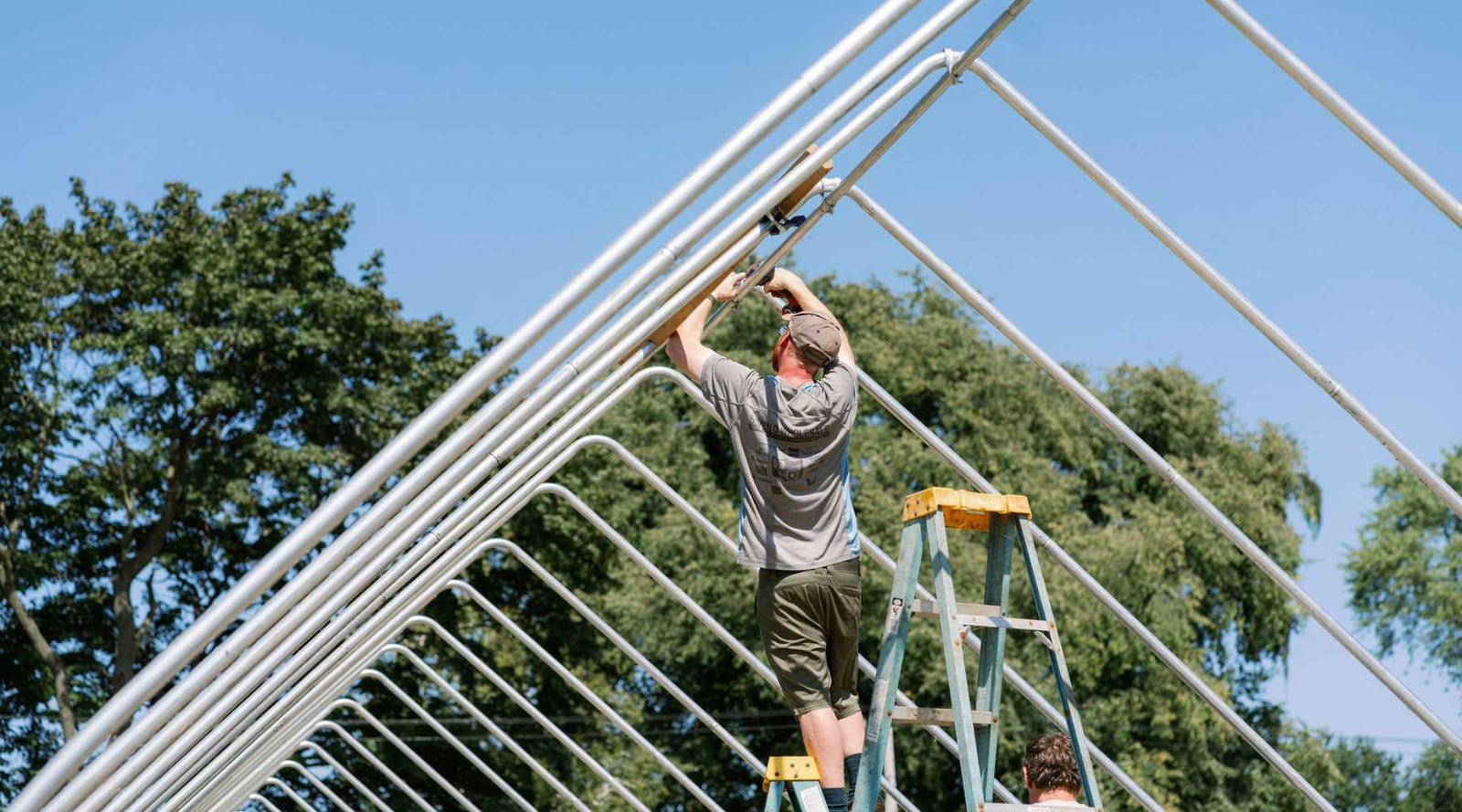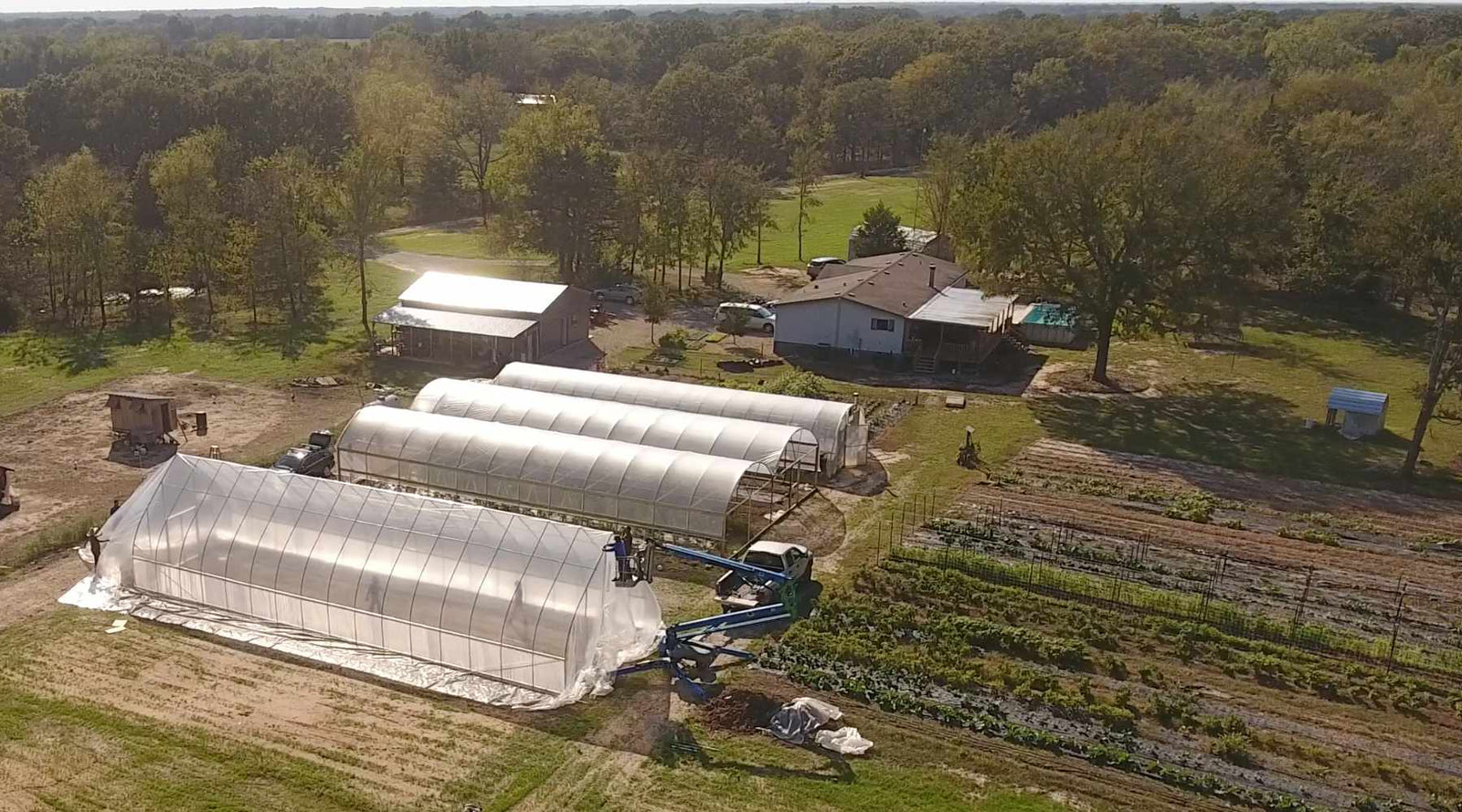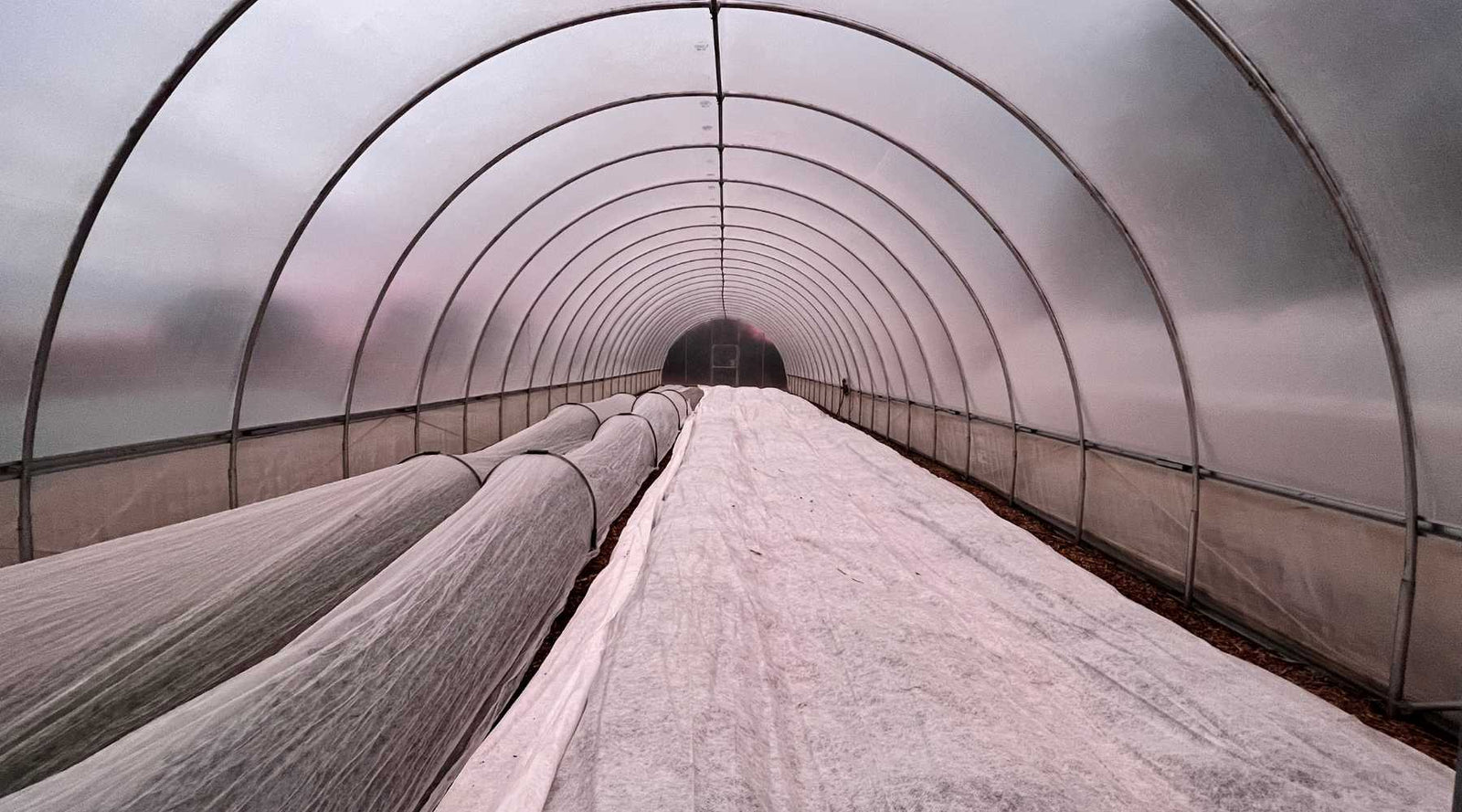Free Shipping on Orders over $75 to the Contiguous US
Free Shipping on Orders over $75 to the Contiguous US
What You Need to Know for Successful Winter Growing in High Tunnels, Greenhouses , and Gardens
August 27, 2024 8 min read 0 Comments

The beautiful thing about modern greenhouse and high tunnel technology is that your operation no longer has to stop or slow down during the long, cold winter months. Even outdoor crops can benefit from some of the same season extending techniques used to grow inside high tunnels.
Along with having a proper high tunnel winter growing setup in place before winter comes knocking, it's also crucial to have a planting schedule laid out so you can have the most successful winter harvest possible.
Having the right tools on hand before the first frost touches your field or garden is the best way to ensure that you can keep healthy crops growing well into the cold.
Getting a Greenhouse Ready for Winter
Preparing your greenhouse for winter by following a few simple tips will keep your structure solid, your plants growing into the colder weather and ensure you are ready to take advantage of sunny days.
- Wash the exterior and interior walls of your greenhouse with mild dish soap and water. Removing dust and accumulated water spots will allow your plants to get the most from the weaker winter sun.
- Tighten your greenhouse plastic and patch any small holes with quality greenhouse repair tape. Preventing wind from entering will not only help your greenhouse retain heat it will also help protect your structure from damage during storms.
- Oil hinges and tighten any bolts and screws that have wiggled loose. Keeping your hardware tight will prevent your structure from shifting in high winds.
- Protect your plants from rodent damage by checking for holes around doors and baseboards. Adding rodent repellent or traps near possible entry points will help ensure the unwanted visitors don’t decide to take advantage of the cozy environment you have built for your plants.
- Take the time to collect, wash and dry any equipment that will be stored in the greenhouse over the winter. Dirty pots and muddy shovels can harbor plant diseases that will survive and thrive in the warmer, humid environment.
- Check your drainage trenches and any gutters for debris before the rains start. Pooling water from poor drainage is easier to prevent than to remove in the middle of a storm.
- Keep a rope long enough to go over the greenhouse or a long handled squeegee on hand to help remove snow build up. Watch this video for a tutorial.
If you plan to grow food throughout the winter in your greenhouse or hoop house, taking time to ensure that you have the proper equipment on hand and a planting schedule in place is invaluable.

Winter Growing Tips
- Plan small succession plantings of winter harvest crops like kale, bok choy, carrots, turnips and other root vegetables to stagger your harvest throughout the coldest months. Using a Jang seeder for succession planting can make this process faster and easier.
- Know the likely frost dates for your area and keep an eye out for unseasonably cold nights.
- Have your supplies and plan ready to go for exceptionally cold nights, this can be as simple as ensuring that you have fuel for your heater and electrical access for fans set up ahead of time.
- Layer plant protection within your greenhouse for the best chance of survival. This means having frost blankets available for more tender crops within the greenhouse.
- Add a thick layer of mulch or dry straw to over wintered crops like garlic, onions and asparagus to keep them protected until spring.
- Consider having a few supplemental lights on hand for seedlings and young plants. This can prevent your crops from getting overly leggy if you have a long stretch of overcast days.
Growing through the winter is possible and rewarding. There is nothing better than taking advantage of a rare sunny day in the winter to tend your plants in the warmth of a well maintained greenhouse. Fresh herbs and tender greens brighten up winter soups and spirits when cold, dark days and long nights keep us inside more than we’d like.

CREATE A WINTER GARDEN PLANTING SCHEDULE
The key to good high tunnel winter growing is to give your plants a head start. Ideally, they should be close to maturity by the time the darkest period of the year begins. During this time, in large swaths of the US, days drop to less than ten hours in length. In order to survive, plants need to be hardy enough to weather the limited sunlight and frigid temperatures. Of course, your high tunnel structure will go a long way toward helping them survive and thrive as well.
Closely following an incremental high tunnel planting schedule will also give you a successful series of crops that lasts through the depths of winter. Staggering your sowings every three to four weeks will cause crops to reach maturity at different periods and allow you to transplant out a new crop each time one is harvested, giving you a steady supply of produce until spring arrives. This will also give you the flexibility to handle potential crop failures and determine the best seeding dates for different crops, which can be applied to future seasons for even greater success.
Keep track of your plantings
This can be as simple as a page in a notebook or a spreadsheet on the computer. Keep notes on your crops so you can fine tune your planting schedule as the season progresses. This will also help you to make modifications and improvements year over year.
The most important facts to keep track of are: Planting date, time to transplant size, and days to maturity for your crops. Keeping track of average temperatures and days of sunlight will also help you to make estimates of how the weather is affecting your plants' days to maturity.
WHICH PLANTS DO BEST IN WINTER?
There are two main categories of winter crops: winter-harvest and overwintered. Overwintered crops are usually planted out in the open and protected by low tunnels, so they remain in the open until they're ready to be harvested in early spring. Winter-harvest crops generally live their entire lives within high tunnels and are harvested throughout winter, so they will thrive the best with the incremental planting schedule described above.
Winter is different in the northern, southern, and western parts of the United States, and that has an effect on which plants will perform best in your winter greenhouse.
The Persephone period is a term used to describe the shortest days of winter for any region but mostly for the north where winter days drop below 10 hours of light. The north has the coldest temperatures and shortest day lengths, while the south maintains warmer temperatures and day lengths over ten hours for much longer. The west tends to have more moderate temperatures throughout the year, especially on the Pacific coastline.
All these factors mean that crops must be planted at different times in summer and fall to reach the ideal level of maturity before winter. For continual harvesting of short grow time crops like tatsoi and lettuce, this is less of a factor but the days of available light will be a factor in days to maturity.

What should you grow in the winter?
Below we have some guidelines for ideal crops to grow in the fall and winter depending on your region. Every micro climate is different and the further north your latitude the more you may need to shift planting dates earlier. If you have an indoor space for starting seedlings and potting up to achieve larger root growth, you can give mid-season transplants a leg up before planting them out.
If you plan to start indoors and transplant out during colder weather, it is doubly important to follow best practices for hardening off your transplants. If you need to brush up on your skills for starting and transplanting seedlings we have a number of helpful articles on our How to Grow Seedlings blog.
BEST WINTER CROPS FOR THE NORTH
- June: broccoli, kale, cauliflower and cabbage
- July:, beets, carrots, parsnips and turnips.
- August: long day onions, lettuce, spinach, chicory and endive, mustard greens, arugula, scallions and radishes
- September: mache, garlic
BEST WINTER CROPS FOR THE SOUTH
Many of the crops listed under August and September can be planted on an ongoing basis throughout the fall and early into winter.
- June: peppers and tomatoes
- July: beans, broccoli, collards, peas, eggplant and summer squash
- August: beets, carrots, parsnips, turnips, parsley, cabbage, kale and potatoes
- September: cilantro, mustard greens, tatsoi or bok choi, miner’s lettuce (Claytonia perfoliata), garlic and short day onions
- October/November: onions, chicory, endive
BEST WINTER CROPS FOR THE WEST
Many of the crops listed under July, August and September can be planted on an ongoing basis throughout the fall and early into winter for the more southern regions.
- June: cucumbers, peppers and tomatoes
- July: kale, broccoli, cauliflower
- August: lettuce, swiss chard, beets, carrots, parsnips, turnips, parsley, cabbage and overwintered sweet onions
- September: cilantro, tatsoi or bok choi, spinach,
- October: kale, mustard greens, garlic, chicory, endive
Related: Is It Time to Pick Your Jalapeños?
COOL SEASON ANNUALS FOR SPRING FLOWERS
There are a number of flowers that can be planted in the fall to provide early spring blooms. Many of these flowers are also edible so be sure and check out our edible flower resources for more on these. Depending on your zone these cool season annuals should be planted between September and October or started indoors in the late winter and planted out in very early spring. Below are a few of our favorite cool season annuals to plant in the fall for early spring blooms.
- Bachelor buttons
- Calendula
- Abutilon
- Snapdragons
- Violas
- Wee Willie Dianthus
- Stock

PREPARING FOR HIGH TUNNEL GREENHOUSE GROWING IN WINTER
If you haven't constructed your high tunnel yet, it would be a good idea to look into the Seasonal High Tunnel Initiative from the Natural Resources Conservation Service, a subset of the USDA. The program may be able to provide financial assistance to your operation to help recoup some of the cost of constructing a high tunnel on your property. The NRCS provides this assistance because high tunnels can help address issues in plant and soil quality, reduce the need for pesticides and limit the amount of water and energy consumption needed to produce a great harvest — all things that will lead to more environmentally friendly, sustainable growing.
Late summer or early fall is a great time to plan your build. This way you will have time to get the build finished before the harsher fall weather kicks in.
Layering Protection Inside a Hoop House
Once you have your high tunnel constructed, there are a few other steps you should take to keep your plants cozy and protected. If you live in a northern area with severe temperature drops, adding extra cover of frost blanket over your rows of plants will help protect them from frost. You can either use low tunnels or simply lay the covering directly over them, depending on the plant. This cover can be removed on warmer days to let the plants breathe and ensure they aren't getting too warm, which could inhibit their growth and encourage diseases.
This strategy can also be used on outdoor crops to keep cool season crops alive through light frosts and give you a jump start on early spring crops. For more on using frost blankets in the greenhouse or the garden check out this article on How and When to Use Frost Blankets.
It's also important to be mindful of how much you water your plants. It can be easy to overwater crops during wintertime, but underwatering is a concern as well. Using a moisture meter can be helpful in determining how much your plants will need.
Double layer inflation kits
A double layer inflation kit is built by adding a second layer of plastic to the top of your high tunnel, generally from hip board to hip board, and installing an inflation fan. The benefits of an inflation kit are many including:
- Increased temperatures inside the greenhouse
- Reduced condensation
- Increased wind and snow protection
- Extension of growing in the shoulder seasons
For more information on double layer inflation kits you can hop over to read the linked article and watch the video.
GET ALL THE SUPPLIES NEEDED FOR HIGH TUNNEL WINTER GROWING AT BOOTSTRAP FARMER
Bootstrap Farmer has durable greenhouse kits to expand your growing season. Our high tunnel greenhouses are sturdy enough to weather even tough winter environments to keep your crops thriving and your business booming.
Also in Building A Greenhouse

Breaking Down the Cost of Greenhouse Installation
December 30, 2025 7 min read 0 Comments
Knowing the potential hidden costs before you order a kit is essential for a successful build

Gothic vs. Round Hoop House Which One is Right for You?
September 24, 2024 11 min read 0 Comments

Managing a Greenhouse | Regulating Humidity & Temperatures
August 28, 2025 12 min read 0 Comments
Recent Articles
- Breaking Down the Cost of Greenhouse Installation
- Gothic vs. Round Hoop House Which One is Right for You?
- Managing a Greenhouse | Regulating Humidity & Temperatures
- What is the Best Plastic Covering to Use for a Greenhouse? Our Guide to Greenhouse Plastic
- Greenhouse Ventilation
- The Best Drip Irrigation Systems: How to Choose an Irrigation System for Your Farm, Garden or Greenhouse
- Hoops Basics and How to Install Hoops
- Stabilizing Your Hoop House for All Kinds of Weather
- How to Install Ground Posts for a Hoop House
- Greenhouse and Hoop House Flooring Options
Subscribe
Sign up to get the latest on sales, new releases and more …
